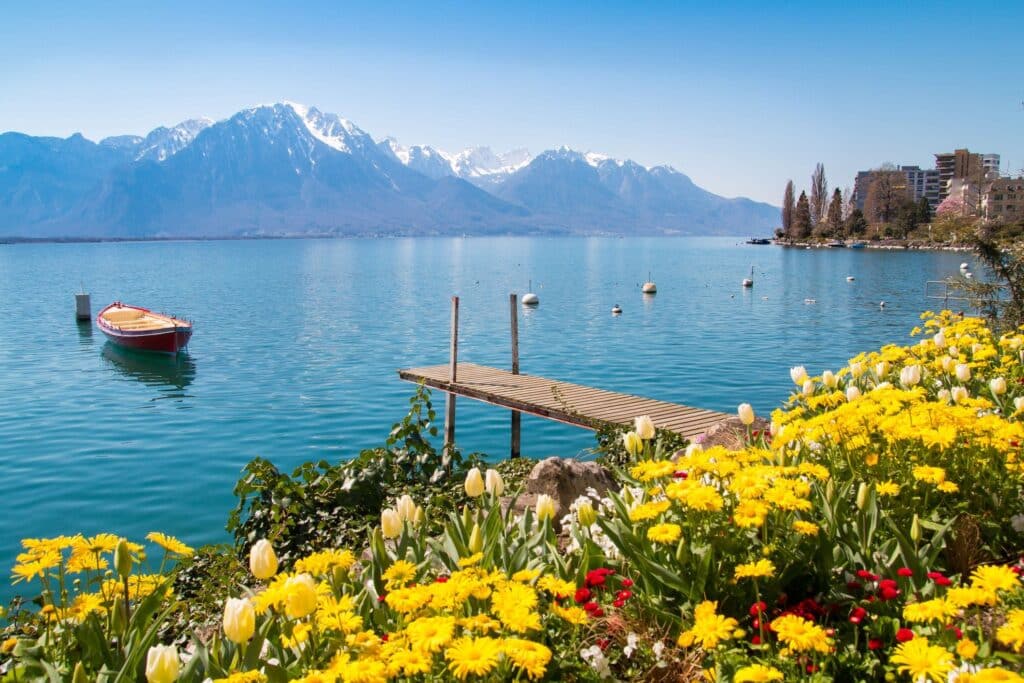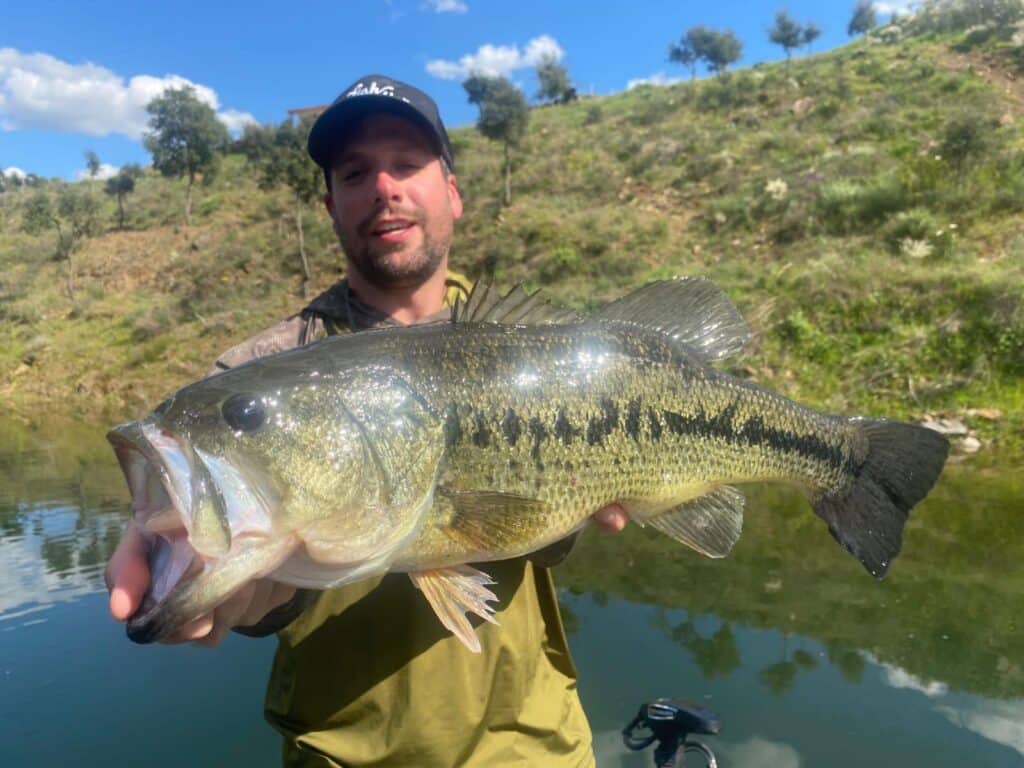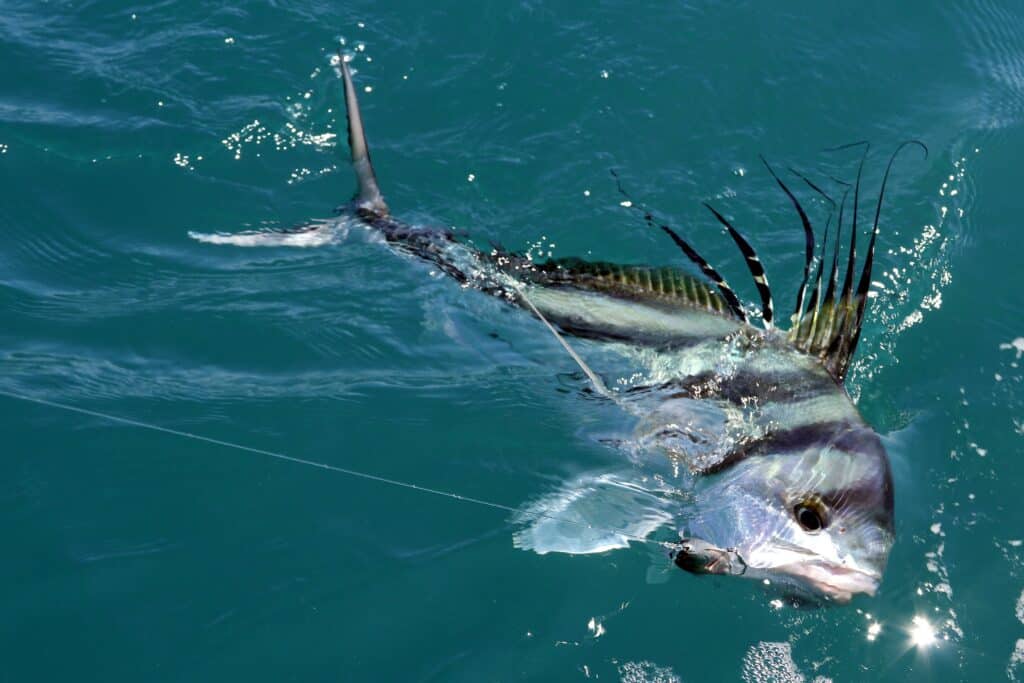
You wish discover fishing in Guadeloupe ? We We wanted to share with you our experience during 7 days of fishing in the company of fishing guides and friends with whom we discovered the wonders of the island.
- Fishing in Guadeloupe: a history of encounters and experience
- Our 1st day of fishing in Guadeloupe: a day to remember
- 2nd day of fishing in Guadeloupe: back to business as usual
- 3rd day of fishing in Guadeloupe: Introduction to kayak fishing
- 4th day of street fishing in Guadeloupe
- One last fishing session... in the river
Fishing in Guadeloupe: a history of encounters and experience
Guadeloupe is an island in the French Caribbean, where the fishing potential is incredibly diverse. It is a magical place to capture several iconic species like the snook, the tarpon or the bonefish. We went there to meet among others two of our partners Rodmaps, Julien and Vincent.

Residing in Guadeloupe for over 17 years now, Julien has spent a lot of time at the edge or on the water. He now knows Guadeloupe like the back of his hand. He co-created the association Guadeloupe passion fishing allowing everyone to discover lure fishing in Guadeloupe. Since then, 10 fishing challenges in Guadeloupe have been organized every year.
He validated his fishing guide diploma in 2014 and has since shared his experience aboard his Skiff.

Vincent has also been a fishing guide in Guadeloupe for several years. He took up post on Julien's second boat with whom he formed a complementary team. in 2018. In the coming days, he will make us discover the joys of fishing in Guadeloupe from his pedal kayaks.
Our meeting with Julien is more than warm! We are impatient to be able to discover the joys of fishing in Guadeloupe and the fish that the island has.
Our 1st day of fishing in Guadeloupe: a day to remember
For this 1er day of fishing in Guadeloupe, we embark on Julien's skiff for fishing on the lagoon. A little navigation is required but also the safety instructions put in place by our guide. For example, we will talk about the positioning of the equipment in the boat so as not to trip, the crushing of the barbs or the way to stand while sailing.
We start fishing in about 10 meters of water. I start the casting jig by scraping the bottom, while Matthieu and Julien fish with shad in open water in linear action and cranking. The first fish are not long in coming. Julien quickly gets his shad shut up by a magnificent yellow trevally. Combat is epic on such a light rod, but after several rushes, it will eventually give up.

A few minutes later, Matthieu will touch a shad tarpon at dusk, but he will cut the line just after the 1er jump out of the area. No luck… But in the meantime, I put two small coubali trevally (caranx crysos) and a yellow trevally in quick succession!

I continue to scrape the bottom with the metal jig and it is an Atlantic Croaker (micropogonias undulatus) which will come up to the boat. A not so obvious fish to catch tells me our fishing guide. A new species validated for the Rodmaps team.

Matthieu regains his confidence by fishing with jerkbait and is harnessed to a pretty barracuda who will show us his acrobatic skills. Julien our guide explains to us that handling this species can be dangerous. It is therefore advisable to be particularly vigilant in order to avoid serious cuts.

The fish seem to react to shiny lures and with rather aggressive swims. This is why Julien takes out a blade. After only two throws, a very large fish is hanged on its rod! At the same time, I hear Matthieu's reel screaming in turn. This is a double. My partner's fish is the first to surrender. It's a yellow trevally.

Photo shoot and release while Julien's fight dragged on without ever seeing the fish. In the end we see the fish a few minutes later. A splendid king mackerel that we measure at 125 centimeters!

A giant for a fish that is in the lagoon. We were lucky not to have had the line cut with such a long fight on such light equipment. It was stung on the outside of the mouth by a single triple branch. We were hot but we had it!
A little tour beyond the barrier
Small briefing to see what we decide to do next. Since the weather is good, we decide to go behind the coral reef to catch new species of fish. It is then that we come out of the water a few small groupers from the rocks posted on the lookout for vulnerable prey.


We then choose to cross the shallow to fish for the break in speed jigging. A few small fish will come to visit us. The EVERGREEN Wolfram is particularly effective on this type of fishing. But no luck because the Spanish mackerel are also out, we will leave some jigs there.
This first day was rich in emotions, in number and especially in diversity of fish. We
The equipment used during this 1st day of fishing in Guadeloupe
- Rods used for light fishing in the lagoon: JABBERS Wanderlust spinning 5 rods, GOLDEN MEAN Deepcore 4 rods.
- Reels used in light in the lagoon: SHIMANO Stella 2500FD, SHIMANO Stella 2500FI.
- Rods used offshore: JABBERS Game Changer 73, JABBERS Game Changer 75.
- Reels used offshore: RYVL 10000 GT ULTRA
- Lures: Jackson Pintail, Keitech Easy Shiner, Blue Blue Sea Ride
2nd day of fishing in Guadeloupe: back to business as usual
The weather conditions being favorable and given the strong activity that there was behind the coral reef the 1st day, we decide to return to the drop offs in this area.
Prospecting with a sounder is essential in order to find fish balls suspended in the water layer. Fortunately Vincent sank a few jigs in time because the number of cuts may be very high today.
First, we see activity on the surface. So we catch the rods equipped with surface lures, and after a few shots of poppers, an explosive attack arrives on my lure from a barracuda doped with steroids.

We insist a little but nothing more on the surface…. So we go back to deep fishing to try to lure pelagic fish.
Jigging in Guadeloupe or the art of getting cut
The conditions are quite ideal for jigging: no wind, very little current, sea of oil. Jigs between 80 grams and 130 grams will therefore be perfectly suited.
After multiple cuts and the breakage of a jigging rod while shoeing, Paul still manages to shoe a Thazard with a metal jig of 80 grams.

To deal with the many cuts, we decided to equip ourselves with steel leaders but also to make the assist hooks in steel. But here, the number of keys drops dramatically! We don't touch anything for more than an hour. So we retrace our steps to find out if the steel changes anything in the behavior of the fish.
As soon as the shock leader is put in place, the hits are not long in being felt in the rod. We continue our research and it is my turn to be harnessed by something very big. The fish is overkill! There is nothing you can do to stop it on my 30lbs and the line ends up cutting. Another failure that begins to put pressure on us all ...
The hour of the shark
However, we do not admit defeat, we notice that the fish that cut us are always well offset in the water layer. Paul lends me his jig fetish. I add an octopus on the single hook to give a hovering side and to target the attack of predators directly on it.
So I decide to use my metal jig on the bottom like a soft lure or an inchiku. The touch is almost instantaneous, a titanic fight ensues, the fish is big and it is particularly fast and powerful because my 10 kilos of brake on my reel RYVL GT10000 Ultra doesn't stop him. It is possible with this reel to go up to 30kg, however I prefer not to take risks and fight this fish within my physical means.

Matthieu, Vincent and Paul observe the fish live on the sounder, but it is not alone and large echoes of the same size as it follow it. We inevitably think of an armada of sharks. It is just before bursting the surface that we see a magnificent silky shark which unhooks just in front of the boat. No need to manipulate it or take risks. The shark begins to swim on the surface to recover from its emotions. We follow it in the thermal in order to observe it well until we see it plunge back into the seabed.
The whole team is very enthusiastic about this fabulous catch. Fishing for sharks with lures is never easy, so it is a great satisfaction for all of us to have touched one during this day of fishing in Guadeloupe.
Back to light jigging for the end of the day's fishing
We continue this second day of fishing in a much shallower area between 10 and 30 meters deep in light tackle. The goal for us is to catch new species thanks to castings jigs between 15 and 30 grams.

We will do a festival of touches. The fish are there and in number. Several varieties of groupers and snappers but also various lizard and trevally fish.

Around us, bonito hunts are breaking out. Vincent, our guide, explains to us that they are very hard to capture because they hunt micro fry.

The problem is not to fish with tiny soft lures but to have a weight heavy enough to cast far enough with a very short hook suitable for micro soft lures. He must also be strong enough to resist their force! Setting up of the special jighead JABBERS: MATCH HEAD! Accompanied by a tiny ZOOM fluke. The skipjack couldn't resist!

The equipment used during this 2nd day of fishing in Guadeloupe
- Rods used for light fishing in the lagoon: JABBERS Wanderlust spinning 5 rods, GOLDEN MEAN Deepcore 4 rods.
- Reels used in light in the lagoon: SHIMANO Stella 2500FD, SHIMANO Stella 2500FI.
- Rods used offshore: JABBERS Game Changer 73, JABBERS Game Changer 75.
- Reels used offshore: RYVL 10000 GT ULTRA
- Lures: Jackson Pintail, Keitech Easy Shiner, Blue Blue Sea Ride
3rd day of fishing in Guadeloupe: Introduction to kayak fishing



We get started with multi-species



We move on to serious matters

The grail, silver color

A quiet return to the port
The equipment used during this 3rd day of fishing in Guadeloupe in Kayak
4th day of street fishing in Guadeloupe

For this 4th day of our fishing trip in Guadeloupe, we meet Paul and Mathilde from Mr and Mrs Fish for a morning meeting at 6 a.m. on one of their favorite streetfishing spot.
We begin the search for predators around the wooden pontoons that border this bay. However, access is quite restricted. But very quickly in the structures located in our feet, we manage to get out of the pufferfishs who are happy to cut our soft lures and mark us the casting jigs!

Then we will chain two small mangrove snappers on the same kind of pits. The sizes remain modest but it's fun!

Change of atmosphere in search of baby tarpons
These few fish caught, Paul and Mathilde decide to change their spot in order to decide on the tarpon babys who hide in the Guadeloupe mangrove. It is a fishing of canals which resembles those which one can find in metropolis.
At the start we only see a few tilapias which shun our lures. They have a very passive, even lethargic, behavior.
Quickly, Paul brings out two tarpon babys in two throws in cramped bay bottoms.

Matthieu will also release two tarpons in quick succession at the OSP Dolive Stick 3 ″ 5. This new spot is huge, the fish seem to be outside and they respond pretty well to our lures!

However, the touch ends up coming to a halt! Suddenly, change of program.
Street session in the port
We head for a new spot on the edge of a professional fishing port. Tarpons can be seen in activities on the surface in the middle of the boats. I throw my stickbait Jabbers Honcho pencil 95, and I hit a magnificent tarpon which unhooks on the second jump! Bad luck!!!
We continue prospecting, between the boats, and it's Matthieu's turn to get his lure sucked: OSP DoliveStick 3 ″ 5. The tarpon delivers a good fight and it is there that a barracuda metered comes to stick to the tarpon in order to be able to taste it. Fortunately Matthieu manages to get it out of the water in time for a video session!
Given the moment of frenzy, we do not take a picture of this tarpon and continue to fish. I will have a big attack on the surface on my popper, but the fish unhook again! It's really hard to sting these fish in topwater because of their bony jaws.
We shift a little outside the port, we see a bank of tarpons getting their pill to brown in the sun like black bass. Matthieu launches his OSP Dolive Stick and a little one intercepts it! Crazy fight and put dry!

We notice that the group of tarpons has barely shifted, Mathilde throws and slips a very beautiful tarpon! The video below:
Change of spot and still madness
The morning was rich in emotions, so we will eat at the local fast food to eat some specialties!

Mr and Mrs Fish leave us after the meal, "work obliges"! We continue Matthew and I to look for tarpons in the city canals. We find an area where the fish are all grouped together and there the hits and catches are no longer counted, we stop counting at 300 hits! It's just crazy!
We will take the opportunity to test all of our equipment and lures in order to unseal any flagship technique.

Fish will follow one another thanks in particular to the Dolive Stick 3 ″ 5 in Texan unlined, alternating jerk and long breaks. We notice that the slight movements of the tide greatly influenced the activity of the baby tarpons and their attacks. So don't hesitate to vary the lures and animations when the keys suddenly stop!
Indeed, the Honcho Pencil subsequently becomes our key to triggering most fish as well as the classic OSP Rudra SP in gold color.

One last fishing session... in the river

We leave with Scarna fishing, and our partner guide, Julien Audonnet, for a freshwater fishing trip in the Guadeloupe mountains. The trip will be done in 4X4 because the path is absolutely impractical for ordinary cars. Julien's Range Rover is an essential tool to access this river.
The climate is much more humid here in this lush jungle, the water flowing along the slippery rocks is limpid and crystalline. A wonderful setting for freshwater fishing in Guadeloupe.
We will try to capture the two new species of fish present in this river:
-the mountain mullet (agonostomus monticola)
-the sleeper (eleotris amblyopsis)
Ultra-light fishing, similar to that of trout
On Julien's advice, we use ultra light and light rods, which is optimal in relation to the weight of the lures used, between 0.5 and 5gr.
The lures of predilections according to Julien are: the rotating and undulating spoons, the small jerkbaits, and micro soft lures.

For mountain mules, we notice that they position themselves in the majority of cases between stones and areas of strong currents! It is therefore necessary to launch your lure upstream to descend faster than the speed of the current. This is the natural behavior of any prey in its waters. This fishing is very similar to that of the trout with lures. It is a fishery that is successful for us because we have a series of catches of varying sizes.

On the other hand, if you prefer to look for sleepers, we recommend that you launch in quiet areas. They stand very close to the bottom without moving a millimeter until their prey passes by, which will trigger a lightning attack. They have a marbled brown coat, a real camouflage, which makes sense for this type of predator.

The fishing over, we all go to the restaurant together to taste local specialties!






